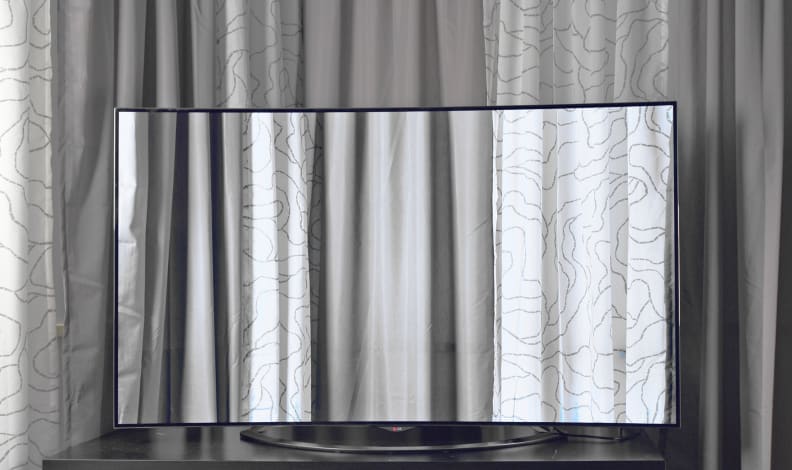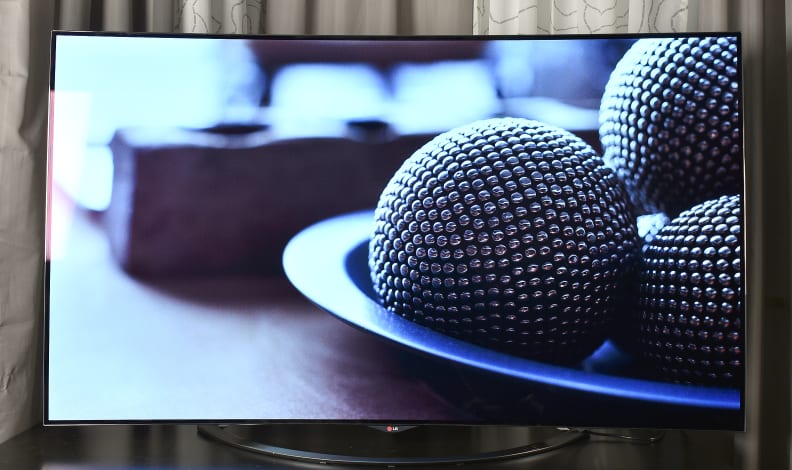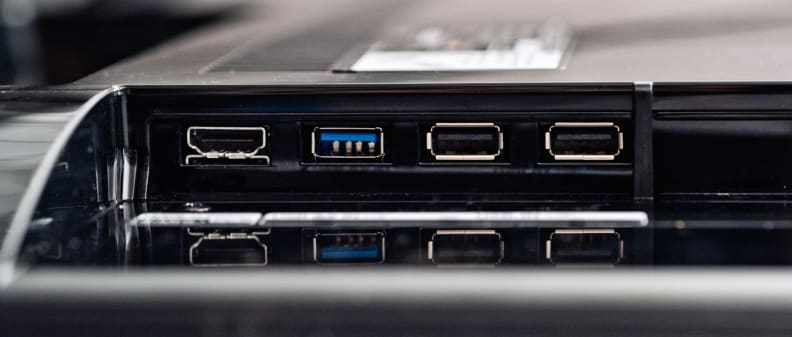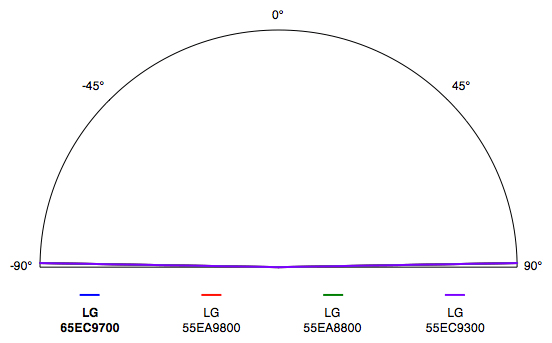First-generation OLED TVs from LG and Samsung delivered incredible contrast performance and picture clarity unrivaled by anything on the market, but topped out at 55 inches and 1080p resolution, vastly limiting consumer choices. Though it's the spiritual successor to plasma—the previous TV tech of choice for videophiles—first-generation OLEDs risked obsolescence in a market prepped for 4K content.
On the other side of the coin, UHD (4K) TVs—offering four times the resolution of those OLED TVs—are an inevitable next step in display tech, and have quickly become available from major manufacturers in almost any size you can imagine. Yet save for a couple of full-array backlit models, most 4K TVs are still held back by the performance pitfalls of edge-lit LED technology, excelling in pixel count, but not contrast, color, or motion.
{{brightcove '3934337292001'}}
As the first 4K OLED on the market, the LG 65EC9700 (MSRP $11,999.99) is incredibly exciting. This marriage of the newest innovations in display tech yields truly breathtaking picture quality, the best we've ever seen. The addition of LG's award-winning webOS platform and the TV's super-slim design is just icing on a very tasty cake.
This is clearly an aspirational product, with a price to match. But realize that this is not merely the flagship product for LG; this is the vanguard product for the TV industry. The future has arrived.
The Picture
As close to perfect as a TV gets in 2014
If you're a TV or movie lover, you know how important the smallest details are: from cinematography to choreography, you want to watch content—not the TV it's playing on. If realistic colors, rich contrast, and cleanly preserved action are the bread and butter of a high-quality viewing experience, the EC9700 is practically a bakery.
As we expected based on previous OLED models, this LG's inky black levels are completely, truly dark, providing the most realistic representation of night scenes and deep shadows on the market. Put the LG beside anything but the best plasma TVs and there's no contest; this is how your content was meant to be enjoyed.
This is par for the course with OLED TVs, but the EC9700 also sets itself apart with a reserved luminance level that doesn't get overly bright save for the showroom-only "Vivid" mode. While that'll make the EC9700 a sub-par choice for brightly lit rooms, the lessened luminance helps balance out the previous issues we've seen with OLEDs involving aggressive light limiting and uneven gamma performance. And given that this is a TV meant for premium home theater setups with appropriately dim viewing conditions, the loss of brightness is hardly a major concern.

Absolute black levels help content stand-out, making for a very immersive viewing experience.
We've heard consistent complaints about OLEDs exhibiting dodgy panel uniformity and image retention. Essentially, low- and middle-gray OLED screens can look uneven or criss-crossed with retained patterns, which is (obviously) rather ugly. The reduced light output of the EC9700 helps stem this issue a bit, but it's also something that clears up over time. After two days of breaking in, I noticed that the EC9700 was dimmer at the sides of the screen than the middle, and that full screen mid-tone grays were rather uneven-looking. After running it another night, however, the edges brightened to nominal levels, and the uneven, retained images were gone. To put it simply: Give the TV a few days to get into its groove when you first boot it up.
The EC9700's biggest improvement compared to previous LG OLEDs, however, is that you don't need to calibrate it to get a world-class setup. In the ISF Expert 1 picture mode, I discovered the best out-of-the-box white balance results I've seen all year, coupled with accurate hues and just a touch of extra saturation in the red and green primaries. In real life, this translates to clean-looking gray and white tones side-by-side with very rich, colorful hues. LCDs in particular tend to struggle to keep errant colors from marring the neutrality of grayscale elements—not so the EC9700. It makes for a very impressive and satisfying image, to say the least.

The EC9700 produces whites and grays with perfect accuracy out of the box, resulting in an extremely realistic picture that deftly mimics reality.
While most of this TV's best performance points owe their prestige to the OLED panel, LG's 4K upscaling process deserves some praise, too. I watched a few Full-HD (1080p) Blu-rays upscaled to 4K, and was impressed with the image and motion clarity. Older content like The Fifth Element had the same "painted" look that we saw on the Vizio P Series, where content looks a bit stretched and over-sharp. On the other hand, newer films like The Dark Knight look so good that I forgot that the movie wasn't 4K after a few minutes—the hallmark of good upscaling and higher-quality film transfers.
Additionally, the 4K resolution gives the EC9700 a leg-up over previous OLEDs for a number of reasons. First of all, normally visible motion artifacts and noise are 75% harder to perceive, as 4K pixels are 75% smaller than their Full-HD counterparts. Secondly, the tiny pixels also make it possible to sit closer to the screen—when you're only a couple of feet away, the curve starts to makes sense. The end result is a viewing experience that surpasses both 1080p OLEDs and 4K LCDs, as it should.

The EC9700 does a good job upscaling 1080p content to near-4K appearance—but native 4K content looks best.
The EC9700 is best-suited for a dark or very dim home-theater style setup, but it can flourish in sunny environments too—though you may want to use the Vivid picture mode in very bright environments. Don't be afraid to wall-mount this TV, either: The subtle curve may make extreme off-angle viewing a bit dodgy, but the TV's horizontal viewing fidelity is just as good as previous OLEDs.
For more detailed test results, charts, and hard data, check out the Science Page.
The Looks
This TV's stunning picture is complemented by a fragile, elegant design.
Over the last decade, flat-panel designers have shaved away extraneous bulk, slimmed the bezels around screens, and shrunk down built-in speakers until they're almost invisible. The 65EC9700 is the epitome of that disappearing act—it's mind-bogglingly thin, with practically no bezels to speak of, and it perches upon a thin, curved metal branch that readily disappears in low-lighting. In short, in the right conditions you're left with nothing but a big, beautiful screen.

The EC9700's super-thin black bezels and curved, hollow stand disappear in low lighting, giving the impression of a huge screen floating in space.
The EC9700 is also curved—a point of some contention amongst reviewers and consumers both. Though we are still skeptical of the benefits of a curved screen, curved OLEDs at least retain contrast and color performance from off angles with no backlight uniformity issues, since there's no backlight in the first place. What's more, the subtle curve is something of a structural necessity because OLED TVs are so thin. In our experience the curvature doesn't add to the viewing experience, but it doesn't take away from it either.

The EC9700's slight curve helps stabilize the panel, which is extremely thin—about the width of a few stacked credit cards.
Whether you dig the curve or not, at least the TV offers an ample suite of video and audio ports. You'll find one HDMI and three USB inputs to the side of the screen for convenience, and three more HDMI inputs, shared component/composite inputs, digital audio out, LAN (ethernet) in, a coaxial jack for cable/antenna, and an RS-232c control port on the back of the TV.

Like other OLED models, the EC9700 is extremely thin—less than half the width of a quarter.
Among the rear inputs, HDMI 1 is HDCP 2.2 compliant; HDMI 2 is the ARC (Audio Return Channel); and HDMI 3 supports 10-bit/12-bit chroma sampling, i.e. color depth. The side input (HDMI 4) is MHL (Micro High-definition Link) compliant, meaning you can play content from a smartphone or tablet through it. All four HDMI inputs support 4K at 60Hz (the best way to render UHD footage right now), ensuring that the EC9700 is fully-equipped for native 4K content as it becomes more widely available.

In the box, LG includes the motion-controlled Magic Remote (with batteries), an owner's manual, polishing cloth, 3D glasses, splitters for the component/composite inputs, and a 4K-capable HDMI cable. In keeping with this TV's posh bearing, everything is neatly packaged in individual boxes—it's a nice touch.
The Experience
webOS is as smooth and peppy as ever.
When you boot up the EC9700, you're immediately greeted by a cute animated bird, named "Bean Bird," who guides you through the set-up process. Tasks that are usually dull as dishwater—like selecting your cable provider, or picking out your WiFi network from a list—are spiced up via cute cartoons and illustrations. If anything, the above-and-beyond attention to detail of the webOS setup process is the perfect example of what makes the whole platform so great.

This 4K OLED wields LG's spectacular webOS smart platform, which is easy to use and beautifully organized.
Each action—opening an app, or switching from HDMI 1 to HDMI 2—is accompanied by a colorful on-screen prompt, lending the interface a kind of creamy smooth compatibility with the user that TVs have been missing for years. The speed and snappy functionality of webOS earned our Best of Year 2014 award, and it's equally intuitive on the EC9700. As my co-worker Michael Desjardin said,
Of all the complimentary things I can say about webOS–from its versatility to its convenience–I was consistently impressed by the software's responsiveness. Thanks in part to LG's Magic Remote, navigation is silky smooth and hopping from one app to another is seamless. There's a distinct lack of lag from menu-to-menu, which can't be said for many smart platforms today.

While there's a lot of content already pre-installed on the TV, you can add more apps and games from LG's app store.
Unfortunately, we can't say the same thing for LG's main menu software. While there's certainly no lack of content within the Picture or Audio menus, the way content jumps from the left side to the bottom half of the screen is frustrating, if only because infrared-based, motion-activated remotes like the Magic Remote are still playing catch-up with TV menus that have been developed with button-based controllers in mind. There's a bit of a learning curve, but what LG really needs is a dedicated smart phone app.
This played into the calibration of the TV, as well. It's fortunate that the EC9700 doesn't require much (if any) tweaking to present a near-perfect image, as doing so with LG's software is very difficult. Like other OLED TVs, the EC9700's light output shifts imperceptibly when the software is on the screen, and dims slightly after a few moments, making the tiny adjustments we do during a professional calibration inconsistent to the point of futility.
What does this mean for most folks? Don't hire a calibrator—you probably won't need one for this particular TV anyway.
If D.I.Y'ers want to try their hand at an at-home calibration, however, the EC9700 offers up all the necessary controls. You'll find a full CMS (Color Management System), 2- and 20-point white balance controls, a gamma selector, and all the usual big-picture adjustments: Color, Contrast, Brightness, and Tint. Just don't say we didn't warn you about how difficult it is.
{{ photo_gallery "software" }}
The Verdict
Is this the future for TVs? We hope so.
In tech reviewing it's easy to throw around superlatives, crowning every brand-new technology as "groundbreaking" or "earth-shattering" when it is little more than a logical step forward in a well-trod category.
In the case of 4K OLED televisions like the EC9700, the superlatives are truly deserved. Hollow words like "incredible" unquestionably apply, because it is difficult to believe that a television can adopt all the best traits of the newest LCDs and dearly departed plasmas with so few drawbacks.
With 4K televisions slowly supplanting the entirety of the high-end TV market, it makes a lot of sense to combine the best panel technology we have today with the resolution we will all want tomorrow. The 65EC9700 may be the first of its kind on the market, but it surely won't be the last.
Yet the most impressive thing about this TV is that LG did the necessary work beyond simply multiplying the pixels in the panel. Many of the recent drawbacks associated with OLED technology—such as aggressive auto-light limiting, excessive image retention, and inconsistent luminance across neutral tones—have been tweaked or fixed entirely via better light and energy management.
The only real drawback, of course, is the price. Right now, the 65EC9700 is $12,000 on LG's website with a $10,000 street price—neither of which are particularly cheap. Yet with 50-inch 4K TVs available for as little as $999, the cost of entry is falling fast. Likewise, the LG 55EA9800—a 1080p OLED model—has dropped in price to just under $2,500 since its release in late 2013. The EC9700 might be prohibitively expensive right now, but we expect the price to drop accordingly over the next year or so. It is likely to remain an aspirational purchase for most people, but LG's mission is clear: Bring this kind of quality down in price as quickly as possible.
Simply put: If you can afford it, this is the best TV money can buy.
Behind The Screens
The LG 65EC9700 (MSRP $11,999.99) is the first of its kind: a beautiful OLED TV equipped with 4K (UHD) resolution. We've been privy to the amazing contrast and color purity of OLED TVs for the last year, but seeing such image fidelity rendered in 4K is truly a sight to behold. Not only does the EC9700 look just as awesome as previous OLEDs, it makes subtle improvements to things only the most staunch cinephiles would even complain about—a real tip of the hat from LG.
From black level to motion, viewing angle, and color production, the EC9700 earns blue ribbons in almost every major performance category. The only place it compares unfavorably to competing LCDs is in terms of luminance falloff. Like a plasma, the EC9700 grows dimmer as more of the screen is filled with light, and grows brighter as light becomes more scarce. The EC9700 is just a little less bright than previous OLEDs, however, which helps lessen the perceptibility of this falloff, and reduces the longevity of image retention.
As I discussed on the front page, I was unable to calibrate this TV due to the way the on-screen software alters the TV's light and color production subtly. It makes it impossible to do things like correct the white balance or even out discrepancies in color production. Fortunately, the EC9700 doesn't really need any calibration—give it 40 or so hours to break in, and it presents an almost perfectly tuned picture all on its own.
Note that the following results were obtained after 48+ hours of use with the OLED Light and Contrast settings set to maximum levels.
Contrast Ratio
Just like with the other OLED TVs we've reviewed, the 65EC9700 is a stellar performer in terms of contrast. A TV's contrast ratio is determined by dividing its reference white (100 IRE) luminance by its black level (0 IRE). Since OLED pixels turn off when they're not in use, OLED black levels are effectively zero. For the sake of scoring and comparison purposes, however, I've again estimated a black level of 0.001 cd/m2 , the equivalent of a glowing power indicator in the same room as the TV.
The EC9700 tested with less overall luminance than LG's previous OLEDs, the EA9800 and EA8800, though still plenty enough for normal lighting. I measured a reference white of 149.90 cd/m2 , though this dropped to ~ 50 cd/m2 during full-field white patterns, but jumped up close to 225 cd/m2 for very small percentages, or for grayscale elements above 100 IRE. Overall, the EC9700's estimated contrast ratio is about 150,000:1, which is simply an unbeatable amount of black/white differentiation, and makes for an extremely pleasing, realistic picture.

Like previous OLED models, the EC9700's contrast performance is well beyond almost any other TV on the market.
Viewing Angle
Viewing angle is another area where OLED TVs excel by an unprecedented amount. Our viewing angle test measures how far from head-on (center) you can view the screen and still see a high-quality image. Like previous OLEDs, the EC9700 measured with a perfect viewing angle—178° total, or ±89° from the center to either side of the screen. Other than discrepancies introduced by the curve of the screen, you can essentially get quality viewing even at nigh perpendicular viewing angles.

Like other OLED TVs, the EC9700 offers up a perfect 178° viewing angle.
Color Gamut
The EC9700 tested with some of the best color production we've seen all year, which is especially impressive considering that OLED is such a new technology. We measure the x/y coordinates of a TV's red, blue, green, and white production against the Rec. 709 standard, allowing for some flexibility in terms of red/green oversaturation. The EC9700's color production is essentially perfect—red and green are a little more saturated than is required by the HDTV standards, but the additional color only adds to the TV's bright, vivid appearance.
This is especially impressive considering it's the default color in ISF Expert 1 mode. Seeing such an accurate white point out of the box (not to mention such accurate secondary colors) is almost non-existent within the realm of LCD TVs.

The EC9700 tested with almost perfect color results in the ISF Expert 1 picture mode.
Grayscale & RGB Balance
Because televisions use an additive color scheme (adding red, green, and blue) to create grayscale (neutral) tones like white and gray, they often struggle to achieve a perfect white balance. Ideally, TVs produce grayscale elements at x = 0.313, y = 0.329, which correlates to a color temperature of 6500 Kelvin. When a TV's primary colors are not emphasized properly, it can cause colored tinting within steps along the grayscale. This is a big issue with uncalibrated LCD TVs, but the EC9700's grayscale production is perceptibly perfect (after about 40 hours of break-in time). I measured a grayscale DeltaE (collective error) of 0.88, where 3 or less is considered ideal.

Even uncalibrated, the EC9700 tested with no perceptible grayscale error—a supremely impressive result.
To get a better idea of where perceptible error comes from—and also how well a TV renders gradations of color and transitions between darker/lighter hues—we also analyze the underlying RGB balance within the grayscale, from 10 to 100 IRE. As you might expect, the EC9700's RGB emphasis is very well balanced, with no over- or under-emphasis more than a few percentages away from perfect. This is very difficult for TVs to achieve, and is yet another impressive result.

The EC9700's RGB balance doesn't stray more than a few percentage from perfect emphasis from the darkest shadow tones to the brightest whites.
Gamma
Gamma, which refers to the progression of midtone luminance out of black and into peak white, is one area where OLED devices—TVs, smartphones, and tablets—have traditionally struggled. This is yet another area where the EC9700 improves upon past OLED TVs. Ideal gamma curves for TVs are 2.2, 2.3, or 2.4, depending on the amount of light in the room.
While the EC9700 tested with a gamma curve of 2.17, it's a much flatter, more consistent gamma than we've seen on previous OLED TVs, with less extreme jumps in luminance from step to step. This isn't a perfect result, but it's still a huge improvement compared to OLEDs we've tested in the past.

Though it's not perfect, the EC9700's semi-flat gamma curve of 2.17 is a big improvement compared to previous OLEDs.
Meet the tester
Lee was Reviewed's point person for most television and home theater products from 2012 until early 2022. Lee received Level II certification in TV calibration from the Imaging Science Foundation in 2013. As Editor of the Home Theater vertical, Lee oversaw reviews of TVs, monitors, soundbars, and Bluetooth speakers. He also reviewed headphones, and has a background in music performance.
Checking our work.
Our team is here to help you buy the best stuff and love what you own. Our writers, editors, and experts obsess over the products we cover to make sure you're confident and satisfied. Have a different opinion about something we recommend? Email us and we'll compare notes.
Shoot us an email


